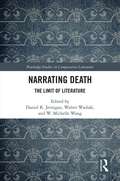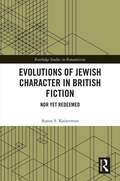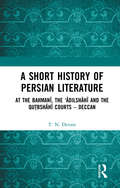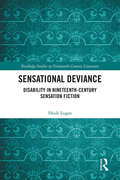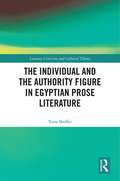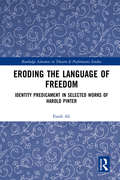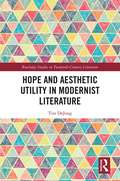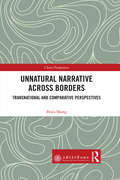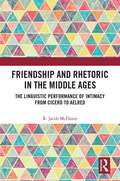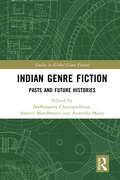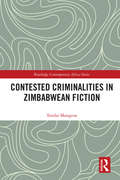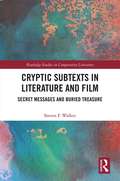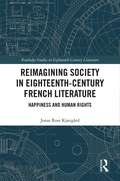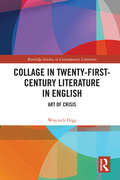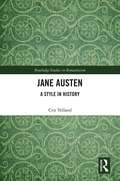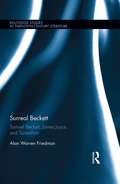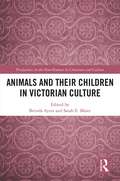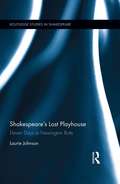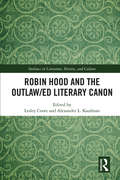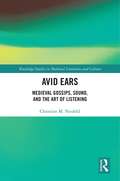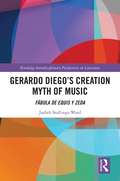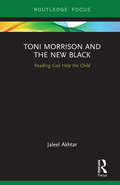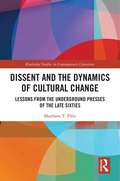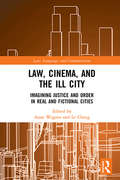- Table View
- List View
Narrating Death: The Limit of Literature
by Daniel K. Jernigan Walter Wadiak W. Michelle WangDrawing on literary and visual texts spanning from the twelfth century to the present, this volume of essays explores what happens when narratives try to push the boundaries of what can be said about death.
Evolutions of Jewish Character in British Fiction: Nor Yet Redeemed (Routledge Studies in Romanticism)
by Aaron KaisermanEvolutions of Jewish Character in British Fiction: Nor Yet Redeemed builds upon recent scholarship concerning representations of Jews in the British Romantic and Victorian periods. Existing studies identify common trends, or link positive Jewish portrayals to authorial interests and social movements; this volume argues that understanding developments in Jewish portrayals can be enhanced by looking at the way antecedent Jewish characters and tropes are negotiated within developing literary movements. Evolutions of Jewish Character in British Fiction examines how the contradictory nature of Jewish stereotypes, combined with the Jews’ complicated entanglement of religion, race, and nationality, presented an opportunity for writers to think about the gap between representations and individuals. The tension between stereotyping and Realist impulses leads to a diversity of Jewish types, but also to an increasingly muddled sense of Jewish interests. This confusion over Jewish identity generated in turn a subgenre of texts that sought to educate readers about Jews by interrogating stereotypes and thinking about the Jews’ relationships to host cultures. In a literary landscape increasingly defined by individuality and Realism, outcast and secretive Jews provided subjects ready-made to reveal the inadequacies of surfaces for understanding the interior self. The replacement of simplistic Jewish stereotypes with morally complex Jewish characters is an effect both of Realism’s valuation of interiority and of the historical movement towards expanding the definitions of British identity.
Evolutions of Jewish Character in British Fiction: Nor Yet Redeemed (Routledge Studies in Romanticism)
by Aaron KaisermanEvolutions of Jewish Character in British Fiction: Nor Yet Redeemed builds upon recent scholarship concerning representations of Jews in the British Romantic and Victorian periods. Existing studies identify common trends, or link positive Jewish portrayals to authorial interests and social movements; this volume argues that understanding developments in Jewish portrayals can be enhanced by looking at the way antecedent Jewish characters and tropes are negotiated within developing literary movements. Evolutions of Jewish Character in British Fiction examines how the contradictory nature of Jewish stereotypes, combined with the Jews’ complicated entanglement of religion, race, and nationality, presented an opportunity for writers to think about the gap between representations and individuals. The tension between stereotyping and Realist impulses leads to a diversity of Jewish types, but also to an increasingly muddled sense of Jewish interests. This confusion over Jewish identity generated in turn a subgenre of texts that sought to educate readers about Jews by interrogating stereotypes and thinking about the Jews’ relationships to host cultures. In a literary landscape increasingly defined by individuality and Realism, outcast and secretive Jews provided subjects ready-made to reveal the inadequacies of surfaces for understanding the interior self. The replacement of simplistic Jewish stereotypes with morally complex Jewish characters is an effect both of Realism’s valuation of interiority and of the historical movement towards expanding the definitions of British identity.
A Short History of Persian Literature: At the Bahmanī, the ‘Ādilshāhī and the Qutbshāhī Courts – Deccan
by T. N. DevareThis is a seminal book, first published in 1961. Over the past six decades, T.N. Devare's work has been widely recognised as a pioneering study to re-discover the glorious heritage of Persian in the Deccan, following the first comprehensive and critical survey completed by the author of Persian manuscript sources and literary works scattered across numerous libraries, archives and repositories in India and abroad.The book convincingly argues that, the Deccan’s multilingual and multi-religious traditions shaped the evolution of Indo-Persian and produced over nearly four centuries, a distinct literary and cultural world marked by a syncretic character which defied social, political or religious boundaries. The author also makes the case for collaboration between Persian and the regional languages of India, particularly Marathi. It is the rich legacy of Persian in the Deccan Courts with their vast treasures of literature that is preserved in Dr Devare’s work.The book has been regarded and continues to remain a foundational text for studying the Deccan, be it in the field of history, literature or culture.Please note: Taylor & Francis does not sell or distribute the Hardback in India, Pakistan, Nepal, Bhutan, Bangladesh and Sri Lanka
Sensational Deviance: Disability in Nineteenth-Century Sensation Fiction (Routledge Studies in Nineteenth Century Literature)
by Heidi LoganSensational Deviance: Disability in Nineteenth-Century Sensation Fiction investigates the representation of disability in fictional works by the leading Victorian sensation novelists Wilkie Collins and Mary Elizabeth Braddon, exploring how disability acts as a major element in the shaping of the sensation novel genre and how various sensation novels respond to traditional viewpoints of disability and to new developments in physiological and psychiatric knowledge. The depictions of disabled characters in sensation fiction frequently deviate strongly from typical depictions of disability in mainstream Victorian literature, undermining its stigmatized positioning as tragic deficit, severe limitation, or pathology. Close readings of nine individual novels situate their investigations of physical, sensory, and cognitive disabilities against the period’s disability discourses and interest in senses, perception, stimuli, the nervous system, and the hereditability of impairments. The importance of moral insanity and degeneration theory within sensation fiction connect the genre with criminal anthropology, suggesting the genre’s further significance in the light of the later emergence of eugenics, psychoanalysis, and genetics.
The Individual and the Authority Figure in Egyptian Prose Literature (Literary Criticism and Cultural Theory)
by Yona ShefferThe Individual and the Authority Figure in Egyptian Prose Literature explores and analyses political conflicts between individuals and authority figures, as those conflicts are depicted in thirteen Egyptian novels written from 1957 to the last years of Mubarak's presidency. The book discusses the various reasons that lead an individual or a group of people from all strata of society (common people, intellectuals, and public figures) to confront policemen, senior security officials, and even the heads of the state. It further examines how the conflicts develop and what their outcomes are in the short term as well as in the long term, for both the individuals and the authority figures. In this context, the volume also examines the possibility of standing against an oppressive regime and even overcoming it. This text argues that while the authority figure initially subdues individuals who confront them, their victory is short term. In the long term, their cruelties bring about sown deaths, either by the individuals themselves or by their relatives. Furthermore, large assemblies of people can confront the regime with success. These discoveries, along with other findings presented in the book, remain relevant to the reality in the Middle East and the events leading to the Arab Spring.
Eroding the Language of Freedom: Identity Predicament in Selected Works of Harold Pinter (Routledge Advances in Theatre & Performance Studies)
by Farah AliLet down by the uncertainties of memory, language, and their own family units, the characters in Harold Pinter’s plays endure persistent struggles to establish their own identities. Eroding the Language of Freedom re-examines how identity is shaped in these plays, arguing that the characters’ failure to function as active members of society speaks volumes to Pinter’s ideological preoccupation with society’s own inadequacies. Pinter described himself as addressing the state of the world through his plays, and in the linguistic games, emotional balancing acts, and recurring scenarios through which he put his characters, readers and audiences can see how he perceived that world.
Hope and Aesthetic Utility in Modernist Literature (Routledge Studies in Twentieth-Century Literature)
by Tim DeJong"Hope" and "modernism" are two words that are not commonly linked. Moving from much-discussed negative affects to positive forms of feeling, Hope and Aesthetic Utility in Modernist Literature argues that they should be. This book contends that much of modernist writing and thought reveals a deeply held confidence about the future, one premised on the social power of art itself. In chapters ranging across a diverse array of canonical writers – Henry James, D.W. Griffith, H.D., Melvin Tolson, and Samuel Beckett – this text locates in their works an optimism linked by a common faith in the necessity of artistic practice for cultural survival. In this way, the famously self-attentive nature of modernism becomes a means, for its central thinkers and artists, of reflecting on what DeJong calls aesthetic utility: the unpredictable, ungovernable capacity of the work of art to shape the future even while envisioning it.
Unnatural Narrative across Borders: Transnational and Comparative Perspectives (China Perspectives)
by Biwu ShangThis book actively engages with current discussion of narratology, and unnatural narrative theory in particular. Unsatisfied with the hegemony of European and Anglo-American narrative theory, it calls for a transnational and comparative turn in unnatural narrative theory, the purpose of which is to draw readers’ attention to those periphery and marginalized narratives produced in places other than England and America. It places equal weight on theoretical exploration and critical practice. The book, in addition to offering a detailed account of current scholarship of unnatural narratology, examines its core issues and critical debates as well as outlining a set of directions for its future development. To present a counterpart of Western unnatural narrative studies, this book specifically takes a close look at the experimental narratives in China and Iraq either synchronically or diachronically. In doing so, it aims, on the one hand, to show how the unnatural narratives are written and to be explained differently from those Western unnatural narrative works, and on the other hand, to use the particular cases to challenge the existing narratological framework so as to further enrich and supplement it. The book will be useful and inspiring to those scholars working in such broad fields as narrative theory, literary criticism, cultural studies, semiotics, media studies, and comparative literature and world literature studies.
Friendship and Rhetoric in the Middle Ages: The Linguistic Performance of Intimacy from Cicero to Aelred
by R. Jacob McDonieFriendship and Rhetoric in the Middle Ages: The Linguistic Performance of Intimacy from Cicero to Aelred covers approximately 1,200 years of literature. This is a book on "medieval literature" that foregrounds language as the agent for cultivating medieval friendship (from the first century BC to c. 1160 AD) in oratorical, ecclesiastical, monastic, and erotic contexts. Taking a different approach than many works in this area, which search for the lived experience of friends behind language, this book stands apart in looking at friendship's enactment through rhetorical language among classical and medieval authors.
Indian Genre Fiction: Pasts and Future Histories (Studies in Global Genre Fiction)
by Bodhisattva Chattopadhyay Aakriti Mandhwani Anwesha MaityThis volume maps the breadth and domain of genre literature in India across seven languages (Tamil, Urdu, Bangla, Hindi, Odia, Marathi and English) and nine genres for the first time. Over the last few decades, detective/crime fiction and especially science fiction/fantasy have slowly made their way into university curricula and consideration by literary critics in India and the West. However, there has been no substantial study of genre fiction in the Indian languages, least of all from a comparative perspective. This volume, with contributions from leading national and international scholars, addresses this lacuna in critical scholarship and provides an overview of diverse genre fictions. Using methods from literary analysis, book history and Indian aesthetic theories, the volume throws light on the variety of contexts in which genre literature is read, activated and used, from political debates surrounding national and regional identities to caste and class conflicts. It shows that Indian genre fiction (including pulp fiction, comics and graphic novels) transmutes across languages, time periods, in translation and through publication processes. While the book focuses on contemporary postcolonial genre literature production, it also draws connections to individual, centuries-long literary traditions of genre literature in the Indian subcontinent. Further, it traces contested hierarchies within these languages as well as current trends in genre fiction criticism. Lucid and comprehensive, this book will be of great interest to academics, students, practitioners, literary critics and historians in the fields of postcolonialism, genre studies, global genre fiction, media and popular culture, South Asian literature, Indian literature, detective fiction, science fiction, romance, crime fiction, horror, mythology, graphic novels, comparative literature and South Asian studies. It will also appeal to the informed general reader.
Contested Criminalities in Zimbabwean Fiction (Routledge Contemporary Africa)
by Tendai MangenaThis book addresses the ways in which writers deploy the trope of contested criminality to expose Zimbabwe's socially and politically oppressive cultures in a wide range of novels and short stories published in English between 1994 and 2016. Some of the most influential authors that are examined in this book are Yvonne Vera, Petina Gappah, NoViolet Bulawayo, Brian Chikwava, Christopher Mlalazi, Tendai Huchu and Virginia Phiri. The author uses the Zimbabwean experience to engage with critical issues facing the African continent and the world, providing a thoughtful reading of contemporary debates on illegal migration, homophobia, state criminality and gender inequalities. The thematic focus of the book represents a departure from what Schulze-Engler notes elsewhere as postcolonial discourse’s habit of suggesting that the legacies of colonialism and the predominance of the ‘global North’ are responsible for injustice in the Global South. Using the context of Zimbabwe, it is shown that colonialism is not the only image of violence and injustice, but that there are other forms of injustice that are of local origin. Throughout the book, it is argued that in speaking about contested criminalities, writers call attention to the fact that laws are violated, some laws are unjust and some crimes are henceforth justified. In this sense crime, (in)justice and the law are portrayed as unstable concepts.
Cryptic Subtexts in Literature and Film: Secret Messages and Buried Treasure
by Steven F WalkerOne of the primary objectives of comparative literature is the study of the relationship of texts, also known as intertextuality, which is a means of contextualizing and analyzing the way literature grows and flourishes through inspiration and imitation, direct or indirect. When the inspiration and imitation is direct and obvious, the study of this rapport falls into the more restricted category of hypertextuality. What the author has labeled a cryptic subtext, however, is an extreme case of hypertextuality. It involves a series of allusions to another text that have been deliberately inserted by the author into the primary text as potential points of reference. This book takes a deep dive into a broad array of literature and film to explore these allusions and the hidden messages therein.
Reimagining Society in 18th Century French Literature: Happiness and Human Rights (Routledge Studies in Eighteenth-Century Literature)
by Jonas Ross KjærgårdThe French revolutionary shift from monarchical to popular sovereignty came clothed in a new political language, a significant part of which was a strange coupling of happiness and rights. In Old Regime ideology, Frenchmen were considered subjects who had no need of understanding why what was prescribed to them would be in the interest of their happiness. The 1789 Declaration of the Rights of Man and of the Citizen equipped the French with a list of inalienable rights and if society would respect those rights, the happiness of all would materialize. This volume explores the authors of fictional literature who contributed alongside pamphleteers, politicians, and philosophers to the establishment of this new political arena, filled with sometimes vague, yet insisting notions of happiness and rights. The shift from monarchical to popular sovereignty and the corollary transition from subjects to citizens culminated in the summer of 1789 but it was preceded by an immense piece of imaginative work.
Collage in Twenty-First-Century Literature in English: Art of Crisis (Routledge Studies in Contemporary Literature)
by Wojciech DragCollage in Twenty-First-Century Literature in English: Art of Crisis considers the phenomenon of the continued relevance of collage, a form established over a hundred years ago, to contemporary literature. It argues that collage is a perfect artistic vehicle to represent the crisis-ridden reality of the twenty-first-century. Being a mixture of fragmentary incompatible voices, collage embodies the chaos of the media-dominated world. Examining the artistic, sociopolitical and personal crises addressed in contemporary collage literature, the book argues that the 21st Century has brought a revival of collage-like novels and essays.
Jane Austen: A Style in History (Routledge Studies in Romanticism)
by Cris YellandFrom 1809 until just before her death, Jane Austen lived in a small, all-female household at Chawton, where reading aloud was the evening's entertainment and a crucial factor in the way Austen formed and modified her writing. This book looks in detail at Jane Austen's style. It discusses her characteristic abstract vocabulary, her adaptations of Johnsonian syntax and how she came to make her most important contribution to the technique of fiction, free indirect discourse. The book draws extensively on historical sources, especially the work of writers like Johnson, Hugh Blair and Thomas Sheridan, and analyses how Austen negotiated her path between the fundamentally masculine concerns of eighteenth-century prescriptivists and her own situation of a female writer reading her work aloud to a female audience.
Surreal Beckett: Samuel Beckett, James Joyce, and Surrealism (Routledge Studies in Twentieth-Century Literature)
by Alan Warren FriedmanSurreal Beckett situates Beckett‘s writings within the context of James Joyce and Surrealism, distinguishing ways in which Beckett forged his own unique path, sometimes in accord with, sometimes at odds with, these two powerful predecessors. Beckett was so deeply enmeshed in Joyce’s circle during his early Paris days (1928 - late 1930s) that James Knowlson dubbed them his "Joyce years." But Surrealism and Surrealists rivaled Joyce for Beckett’s early and continuing attention, if not affection, so that Raymond Federman called 1929-45 Beckett’s "surrealist period." Considering both claims, this volume delves deeper into each argument by obscuring the boundaries between theses differentiating studies. These received wisdoms largely maintain that Beckett’s Joycean connection and influence developed a negative impact in his early works, and that Beckett only found his voice when he broke the connection after Joyce’s death. Beckett came to accept his own inner darkness as his subject matter, writing in French and using a first-person narrative voice in his fiction and competing personal voices in his plays. Critics have mainly viewed Beckett’s Surrealist connections as roughly co-terminus with Joycean ones, and ultimately of little enduring consequence. Surreal Beckett argues that both early influences went much deeper for Beckett as he made his own unique way forward, transforming them, particularly Surrealist ones, into resources that he drew upon his entire career. Ultimately, Beckett endowed his characters with resources sufficient to transcend limitations their surreal circumstances imposed upon them.
Animals and Their Children in Victorian Culture (Perspectives on the Non-Human in Literature and Culture)
by Brenda Ayres Sarah Elizabeth MaierWhether a secularized morality, biblical worldview, or unstated set of mores, the Victorian period can and always will be distinguished from those before and after for its pervasive sense of the "proper way" of thinking, speaking, doing, and acting. Animals in literature taught Victorian children how to be behave. If you are a postmodern posthumanist, you might argue, "But the animals in literature did not write their own accounts." Animal characters may be the creations of writers’ imagination, but animals did and do exist in their own right, as did and do humans. The original essays in Animals and Their Children in Victorian explore the representation of animals in children’s literature by resisting an anthropomorphized perception of them. Instead of focusing on the domestication of animals, this book analyzes how animals in literature "civilize" children, teaching them how to get along with fellow creatures—both human and nonhuman.
Shakespeare's Lost Playhouse: Eleven Days at Newington Butts (Routledge Studies in Shakespeare)
by Laurie JohnsonThe playhouse at Newington Butts has long remained on the fringes of histories of Shakespeare’s career and of the golden age of the theatre with which his name is associated. A mile outside London, and relatively disused by the time Shakespeare began his career in the theatre, this playhouse has been easy to forget. Yet for eleven days in June, 1594, it was home to the two companies that would come to dominate the London theatres. Thanks to the ledgers of theatre entrepreneur, Philip Henslowe, we have a record of this short venture. Shakespeare's Lost Playhouse is an exploration of a brief moment in time when the focus of the theatrical world in England was on this small playhouse. To write this history, Laurie Johnson draws on archival studies, archaeology, environmental studies, geography, social, political, and cultural studies as well as methods developed within literary and theatre history to expand the scope of our understanding of the theatres, the rise of the playing business, and the formations of the playing companies.
Robin Hood and the Outlaw/ed Literary Canon (Outlaws in Literature, History, and Culture)
by Lesley Coote Alexander L. KaufmanThis cutting-edge volume demonstrates both the literary quality and the socio-economic importance of works on "the matter of the greenwood" over a long chronological period. These include drama texts, prose literature and novels (among them, children's literature), and poetry. Whilst some of these are anonymous, others are by acknowledged canonical writers such as William Shakespeare, Ben Jonson, and John Keats. The editors and the contributors argue that it is vitally important to include Robin Hood texts in the canon of English literary works, because of the high quality of many of these texts, and because of their significance in the development of English literature.
Avid Ears: Medieval Gossips, Sound and the Art of Listening
by Christine M NeufeldArguing that women’s "silencing" is in part the result of women’s voices being treated as the white noise of history, Avid Ears: Medieval Gossips, Sound, and the Art of Listening explores the historical representation of female voices as actual acoustic phenomena. The volume focuses on English antifeminist satire during the linguistically dynamic late Middle Ages to argue that the resonant gossips’ circle offers a cultural poetics of listening for those attentive to medieval auditory regimes. Understanding what it means to listen from both medieval and modern perspectives can challenge, so this book argues, the specular logic informing a long satirical tradition that casts the noisy speaking woman as the nemesis who confirms the social authority of the erudite man. Discerning the acoustic preoccupations of the gossips’ circle inevitably hovering behind the shrew, Avid Ears explains why the threat posed by a woman talking back to a man is only exceeded by that of a woman speaking to other women. The first book-length study to use sound studies to explore how gender registers in the medieval literary soundscape, Avid Ears attunes critics to how and what we hear when women speak in literature.
Gerardo Diego’s Creation Myth of Music: Fábula de Equis y Zeda (Routledge Interdisciplinary Perspectives on Literature)
by Judith Stallings-WardSince its publication nearly eight decades ago, the consensus among scholars about Fábula de Equis y Zeda, by the Spanish poet Gerardo Diego (1896-1987) remains unchanged: Fábula is an enigmatic avant-garde curiosity. It seems to rob the reader of the reason necessary to interpret it, even as it lures him or her ineluctably to the task; nevertheless, the present study makes the case that this work is, in fact, not inaccessible, and that what the anhelante arquitecto, intended with his masterpiece was a creation myth that explains the evolution of music in his day. This monograph unlocks the fullness of the poem´s meaning sourced in music’s mythical consciousness and expressed in a poetic idiom that replicates aesthetic concepts and cubist strategies of form embraced by the neoclassical composers Bartok, Falla, Ravel, and Stravinsky.
Toni Morrison and the New Black: Reading God Help the Child
by Jaleel AkhtarToni Morrison and the New Black examines how Morrison explores the concept of the new black in the context of post-soul, post-black and post-racial discourses. Morrison evolves the new black as symbolic of unprecedented black success in all walks of life, from politics to the media, business and beyond.The author's work shows how the new black reaffirms the possibility of upward mobility and success, and stands as testimony to the American Dream that anyone can achieve material success provided they work hard enough for it.
Dissent and the Dynamics of Cultural Change: Lessons from the Underground Presses of the Late Sixties (Routledge Studies in Contemporary Literature)
by Matthew T. PiferDissent and the Dynamics of Cultural Change: Lessons from the Underground Presses of the Late Sixties, examines alternative presses’ critique of culture at a time of infamous transformation and revolution in the United States. In this new study, author Matthew Pifer seeks to delineate the structure of dissent to better understand how cultural change is realized, and explores the relationships between the public and those cultural institutions that define the values and social norms that shaped daily life.
Law, Cinema, and the Ill City: Imagining Justice and Order in Real and Fictional Cities (Law, Language and Communication)
by Anne Wagner Le ChengThis book uses film and television as a resource for addressing the social and legal ills of the city. It presents a range of approaches to view the ill city through cinematic and televisual characterization in urban frameworks, political contexts, and cultural settings. Each chapter deconstructs the meaning of urban space as public space while critically generating a focus on order and justice, exploring issues such as state disorder, lawlessness, and revenge. The approach presents a careful balance between theory and application. The original and novel ideas presented in this book will be essential reading for those interested in the presentation of law and place in cultural texts such as film.
